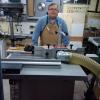The uni gauge looks awesome. I made something similar for my shaper using stuff I had around and a dial indicator from a magnetic indicator base. Makes identifying the problem easier, didn't make solving it any more fun, bu at least you can see where the error is and exactly what it is. The delta has three points of contact on the yoke/cartridge assembly, and getting it perpendicular if it is not takes some patience, a good dial indicator set up sure helps versus feeler gauges. Shimming the cope is probably easier, you will have some minor mis alignment of parts on the molded part of the sticking, but this can usually be clamped out.
"A good miter set up is like yoga pants: it makes everyone's butts look good." Prashun Patel




 Reply With Quote
Reply With Quote


